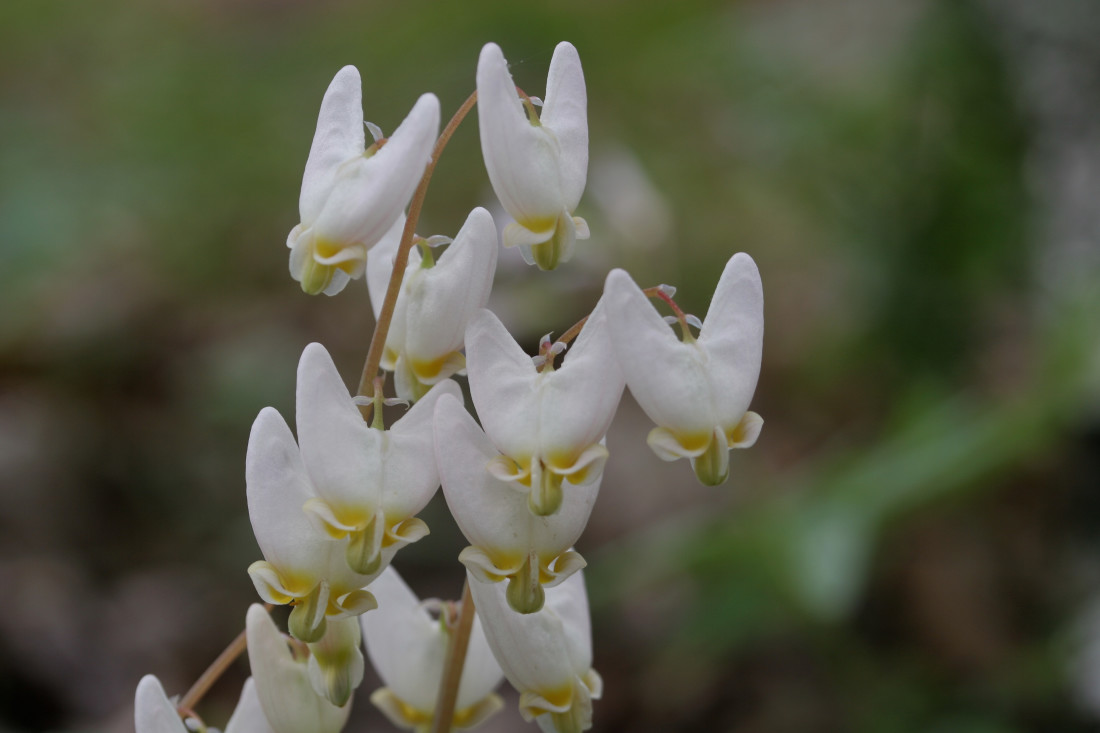BY TAL GALTON
One of Earth’s great spectacles is coming soon to a patch of woods near you. For the past 10 months, multitudes of tubers and bulblets have been patiently hiding in the rich soil of our Appalachian forests. In February and March, they are awakened by increasing sunlight and warmth. In April, a lush carpet of green emerges from the forest floor, and an astonishing array of flowers opens to the bright sunshine.
But unlike, say a thundering herd of caribou, this upwelling of spring ephemerals is a subtle display of nature’s wealth. If your eyes are not honed to pick out the particulars from the forest’s profusion of undergrowth, ask a knowledgeable friend or guide to point out the little miracles at your feet. These diverse plants contain contradictions: They are common, but great displays can be hard to see; they are ephemeral yet long-lived perennials.
Not all Appalachian forests are equal when it comes to the spring ephemeral show. Many of our valleys and slopes are covered in acid cove forests, dominated by thickets of mountain laurel and rhododendron. The floor of an acid cove is relatively dark and barren; the soil is nutrient-poor, and the laurels cast shade year-round. These forests host a sparsely distributed assortment of orchids, pipsissewa, ground cedar and other hemiparasitic plants that have low photosynthetic and nutritional needs.
By contrast, the floor of a rich cove is seasonally dense with bright green undergrowth. The canopy of rich cove forests are marked by basswoods, buckeyes and critically threatened white ash trees. Few evergreen shrubs shade the forest floor of a rich cove, and come April, the ground springs to life with herbaceous plants.
Dozens of species inhabit these woods: Bellworts nod their shaggy yellow blossoms, and the purple larkspur and trillium catch eyes with their taller stature and brightly colored flowers. But there are many less conspicuous flowers, too. For instance, the Dicentra cousins, Dutchman’s breeches and squirrel corn — with their lacy foliage and tiny but evocative flowers — are some of the strongest indicators of rich cove habitat but are easily overlooked. Their bloom period is early, barely a week long, and not to be missed.
Ecological niches are framed in dimensions of both space and time. The when of an organism’s activity (spring/fall or day/night) is as relevant as the where (forest/desert or acid cove/rich cove). The niche the ephemerals fill is as much a temporal one as a geographic one. The truest ephemerals — trout lilies, the Dicentra cousins, spring beauties and a few others — do all of their aboveground business in an exceedingly short time frame.
More sunlight reaches the floor of a deciduous forest in March and April than any other time of year. To take advantage of this apogee of light, they begin to emerge in March. During April, they unfurl their foliage, bloom and go to seed. Via the alchemy of photosynthesis, they hastily make as much sugar as they can from thin air and sunshine. These carbohydrates power the fruiting process, and surplus is stashed in the tuber for future springs.
The plants tread a thin border between thriving and nonexistence. If a spring is too cold or too dry, they need to save enough calories underground to try again the following year. Many don’t realize that ramps, one of the mountains’ most popular wild foods, are one of these long-lived spring ephemerals — important information as we develop a sustainable harvest strategy.
Ephemerals also have fascinating sex lives. They flirt with bumblebee queens, the only hive member that overwinters. The ephemerals’ pollen and nectar are important sources of energy for the queens as they strive to rebuild their summer colony. After pollination, the ephemerals hastily set seed. Many of the earliest flowers grow a tiny fatty appendage called an eliaosome on each seed. Hungry ants, emerging from hibernation, race for these lipid nuggets. Out of convenience, they bring the entire seed back to the colony, fortuitously planting it in a patch of newly aerated soil. The ephemerals have other methods of reproducing, but this is one of the more compelling examples of propagation.
In May, the deciduous canopy closes. A mere six weeks after the ephemerals leaf out, their aboveground parts wither into yellow stalks, leaving hardly a trace to the casual observer. For the ephemerals, life is a race through these bright but fickle months. When the hardwood canopy closes, they regress to underground bulblets or tubers for the next 46 weeks of dormancy.
Despite their apparent fleeting nature, these diminutive plants are actually long-lived perennials — some individuals may, in fact, be as old as the trees that tower overhead. The age of trees is often self-evident; wizened ones with massive trunks and majestic limbs are old. To our eyes, the tender flowers of ephemerals appear young and fresh. Their mature parts are hidden underground as gnarled roots and rhizomes. Their tubers often have marks for each year of growth, but the oldest parts have decayed away. This makes it difficult to discern the age of these plants; it is likely that many are decades old — perhaps much older.
In order to see the ephemerals’ wonderful forms and stages, you need to act quickly and walk in the woods with regularity. Though not necessarily in their ideal rich cove habitat, representatives of many of these species can be found at The Botanical Gardens at Asheville. When you visit them, take a moment to marvel at how these exquisite little flowers are a small part of the whole picture.
Burnsville resident Tal Galton is a naturalist who loves introducing people to wild places. He runs Snakeroot Ecotours in Yancey County.




Before you comment
The comments section is here to provide a platform for civil dialogue on the issues we face together as a local community. Xpress is committed to offering this platform for all voices, but when the tone of the discussion gets nasty or strays off topic, we believe many people choose not to participate. Xpress editors are determined to moderate comments to ensure a constructive interchange is maintained. All comments judged not to be in keeping with the spirit of civil discourse will be removed and repeat violators will be banned. See here for our terms of service. Thank you for being part of this effort to promote respectful discussion.